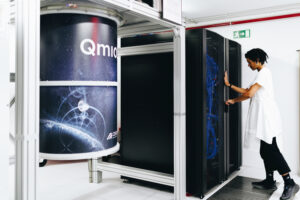CESGA leads the first case of the use of quantum computing for the modeling of taste perception worldwide
Oil and water don’t mix, they say. If we were to look for a way to modernize this popular expression we might ask: do beer and quantum computing mix? Well, actually, they do, mainly due to CESGA and its project with Hijos de Rivera, Fujitsu, and the Catholic University of Murcia to evaluate the molecules responsible for the sensation of freshness in beer using quantum computing
The degree of freshness of beer directly influences the taste, the perceived quality, and the overall drinking experience. The word “refreshing” is often the first that comes to mind when imagining a glass of beer, which is why breweries place such importance on enhancing the connection between their products and the sensation of freshness.

This is why the R&D department of Hijos de Rivera, the parent company behind brands such as Estrella Galicia and 1906, has been researching for five years how different taste receptors on the tongue bind with molecules to understand the mechanics of taste perception better. The potential of quantum computing to help address and analyze these intricate chemical processes was the goal of the collaboration with CESGA, Fujitsu, and the Catholic University of Murcia.
The aim is to identify specific hop molecules capable of generating a greater sensation of freshness, taking as a reference standard an organic compound synonymous with freshness: menthol. The long-term expectation is to translate these findings into the industrial production of beer.
At a time when quantum technologies are still in the experimental phase and their applicability is still more an idea than a reality, this project marks a very important milestone: it is the first case of the use of quantum computing for the modeling of taste perception worldwide.
The key ingredient
Hops are one of the main ingredients in beer brewing. Depending on the variety used, they confer certain aroma and flavor profiles but also act as a natural preservative, enhancing the beer’s clarity and contributing to its stability. Moreover, hops are the primary source of the characteristic bitterness of this beverage, one of the most appreciated by consumers worldwide.
Mariamo Mussa Juane, researcher of the quantum computing team of the Department of Applications and Projects at CESGA, explains that this project, developed within the framework of the Complementary Quantum Communication Plan (PCCC), aims to establish a long-term relationship with Hijos de Rivera. In addition, she clarifies that classifying the most similar molecules to menthol in hops is the first step in a project with a broader goal: to use quantum computing to integrate functional ingredients in food. These ingredients would not only provide basic nutrition but also offer additional health benefits.
“When studying freshness by means of classical computing, Hijos de Rivera observed that the behavior of certain molecules was not as expected. The collaboration is based on trying to solve the problem with this new way of computing: quantum computing,” summarizes Mussa.
The hybrid classical-quantum alliance
“To provide answers to industrial problems, we must create algorithms that adapt to the available technology,” says Mussa. And the most efficient ones while the hardware does not advance significantly are the hybrid classical-quantum algorithms, called VQA (variational quantum algorithms).
“The computing we work with is hybrid, since it has a parameterized quantum block and a classical block to find the parameters that reach the solution. The finer the definition of the two parts, classical and quantum, the finer the solution,” explains the CESGA researcher.
This is the context in which research in quantum computing is currently taking place, the best given the conditions of the noisy intermediate-scale quantum (NISQ) era. This concept refers to the fact that, for the moment, quantum computers are still small and noisy, the latter referring, in very simple terms, to the fact that they are very prone to errors.
How does this apply to the project in question? In essence, the quantum model defines a graph, which is a set of nodes connected by links that represents the structure of the molecule and its physicochemical properties. Next, a quantum algorithm is created that can translate the model into mathematical language for computational processing. Finally, a classical algorithm modifies the parameters of the quantum algorithm in an optimization loop to obtain results. The aim is to compare the graph of the study molecule (a hop molecule) to the reference molecule (menthol), obtaining a similarity result on a scale from 0 to 1, so that the fresher (i.e., the more similar to menthol) the molecule is, the closer it is to 1.
With regard to the beer industry, this allows a numerical scale to classify the molecules present in hops according to their capacity to generate freshness. In this way, it is possible to foresee with a high degree of reliability which are the most promising molecules before submitting them to in vitro tests, which contributes to improve their processes making them more efficient in terms of time and costs.
The role of the quantum emulator, a program that reproduces the behavior of a quantum computer by means of a classical device, is fundamental in this process. For the time being, it is the prelude to using real machines such as the QMIO, CESGA’s quantum computer. “QMIO is a limited resource, it is up to us to use it responsibly,” explains Mussa.
“This way, we can refine the model as much as possible to find the solution more accurately, analyze the effect of varying certain parameters, or evaluate the algorithm’s limitations as we scale the problem. The emulation is useful for analyzing the validity of the quantum computer when solving a certain model. Once it works in emulation, we take it to the real quantum computer. The good results achieved give us a solid starting point to start working with QMIO,” she explains. In sum, the idea is to avoid wasting quantum computing resources as much as possible at a time when they are very limited.
Very promising results
The emulation experiments performed so far tested 62 molecules of hops, with very good comparison results with menthol: “We obtained approximation ratios higher than 0.94. With this kind of algorithms, it is difficult to achieve such precision,” says the CESGA researcher. “In almost a year of work, with a lot of involvement of all parties, we managed to solve the behavior of molecules with quantum computing, something that classical algorithms could not achieve.”
Last June, Hijos de Rivera presented the first results of QMIO for this algorithm at the Biodays Biotechnology Industry Congress. In its process of refining the design of the experiment to better approximate the solution, the project team is now focusing on icilin, the smallest molecule in hops. The results are still very noisy, so the goal is to minimize errors as much as possible.
“These QMIO runs show the viability of quantum computing to address larger industrial problems once the technology is ready for production,” explains Mussa. Regarding the extension of its powerful applications, she states that “these optimization algorithms are applicable in any field that requires decision making.”
The quantum future
For Mariamo Mussa, the QMIO, one of the public access quantum computers with the most qubits in Europe, “is a continuous creator of knowledge.” Although her project is a milestone in the industrial application of quantum computing, she does not lose sight of the experimental stage in which these technologies are still at present and also wants to be cautious about expectations. “Regarding these quantum optimization algorithms, there is a very specific advantage: they encode certain problems to be solved in a more optimized manner. I say certain problems because we do not expect quantum computing to solve everything.” In particular, she mentions combinatorial problems as a field that will especially benefit from the advance of this technology.
In her opinion, the future depends mainly on hardware advances. “The better characterized the quantum processors are, the more accurate the results will be and the greater the problems we will be able to solve.”
In the meantime, she states that the key lies in interdisciplinary collaboration. “It is necessary to open ourselves to share knowledge with different areas and people in order to expand the development of quantum computing.” A reflection that she makes from the condition of a specialist in linear physics who initially felt she was an intruder in the quantum world but today may assert that her training is enabling her to work with QMIO “in a more resilient way.”
Contacto: mmussa@cesga.es
